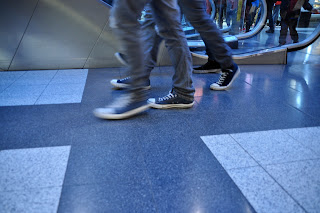As part of my research we went on our own psychogeography walk. We did not plan this walk but walked adrift through the city not walking through an area which we would ordinarily do. This was to explore the city in a new light and see new places.
Below are the images I captured on the walk. I have split them into sections/topics I may wish to explore further within this project. My first set of images concentrate on the idea of architecture. I thought it may be interesting to look at new and old architecture within the city and signs on the buildings as to what the building once was and what it is today.
I felt this building was very interesting. it stood in our university car park. It has no use and has not been used in some time, but why is it there? Why have they started knocking it down but then just left it?
This pipe clearly used to link to a building, but the building no longer stands there. It interests me that this pipe is left with no use yet it still remains as if there was a building still stood there.
I find churches very fascinating buildings within the city. The grand size and scale of the building show how churches used be important and standout.
I particularly liked this building due to its sign "Manchester and Salford Savings Bank". Today we see banks of big modern buildings but this show a building that looks like it could be a house.
My next images focus on abandonment, things that just seem to be have been left behind and forgotten about.
The two images of gloves above interested me as when I took my images the other hand was missing, so not only had someone lost their glove but they only lost one of them. I also liked the decay on the glove suggesting they have been there a long time and no one has picked them up and thrown them away.
This image shows an egg shell that has fallen perfectly inbetween some double yellow lines. Not only that but where is the yolk? There is only shell there, this is why I believe this to be an interesting image.
This image clearly shows what most of used to living within a city to see every day, rubbish abandoned/ disregarded without a thought.
I also liked this image due to the thought of how a person can lose one shoe.
When I captured this image I was thinking about the idea of standing on things you would not ordinarily stand on. This is a door I am stood on, doors are usually open and closed not stood on.
This door says "joey's room" on it, suggesting that it was maybe a child's bedroom door, but now this door lays in a car park abandoned there. I liked this image as it does make you think why this door is here, what happened to the family?
This image amuses me because of the idea that theses bananas are on top of someones house.
My next images are about the city's transport.
This canal is a man made river system which runs through a city which was made for transporting goods. Most inner city canals are abandoned nowadays due to more economically affordable roads providing a more direct route to many destinations.
I thought I may focus my project on traffic.
Along side transport comes road names and places because transport takes you to places and you need to know the name of a place to get there.

I liked the way in which the only canal sits next to the sky line of the city.
This image was taken in the train station. I find it fascinating how much waiting we do, waiting for trains, buses, taxies etc.
This image shows a group of people as a train arrive. I like the expressionless faces everyone has expressing a boredom in waiting.
I also looked into the idea of feet. Our feet take us everywhere and I was interested in the idea that if I took images of just feet walking past do we still make an expression of what type of person they are. I thought this project would be great to do in the city as it is so busy.
Within this image without seeing the woman in the middles head I assume is a very smart person who is possibly dressed for work.
I partially liked this image as all three people are wearing the same shoes. It certainly reinforces that we like people who like the same things as we do and in fact they are all wearing the same shoes.
From just seeing this man's shoes you get a feeling due to the messy, dirtyness of them that he does not care much for his appearance.
I like these images as I do make assumptions in my mind as to the type of people I had phtographed wihout seeing the rest of their body. I also liked the busyness on everyone, which to me certainly suggests the city.


















































